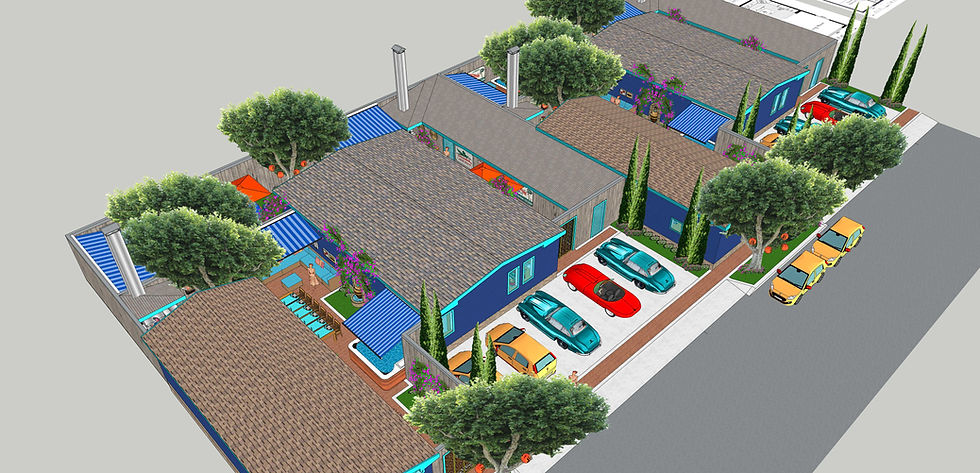🚫 The Trailer Park Killer 🚫
- robert carpenter
- Sep 6, 2025
- 3 min read
Why the Micro-Compound is the Future of Manufactured Housing
For decades, the phrase “trailer park” has been synonymous with stigma. Rows of metal boxes lined up on gravel pads, little to no storage, scarce parking, and the dreaded pad-rent model where residents build no equity and municipalities see little tax value. Local councils fight them, neighbors oppose them, and investors hesitate. Coxsackie, NY was just one of many recent cases where the old model was told, loudly and clearly: hell no.
And yet — demand for affordable housing has never been higher. Manufactured homes remain the most cost-effective way to house Americans. The problem is not the product. The problem is the packaging.
That is where the Micro-Compound comes in. It is nothing less than the Trailer Park Killer.
🔹 What’s Wrong With the Old Model
Traditional trailer parks failed because they:
Depend on rows of trailers separated by dead zones of wasted land.
Extract pad rent without creating ownership opportunities.
Appear tax-negative to municipalities (low assessments, high service costs).
Offer almost no storage, gardens, or dignified amenities.
Carry an unshakable stigma of decline, poverty, and blight.
It is a model that cannot pass local approvals, cannot inspire homeowners, and cannot survive long-term.
🔹 The Micro-Compound Model
Now imagine something entirely different on a 75×75 ft lot:
Two dwellings: a 1,000 sq ft 3-bedroom home + a 600 sq ft ADU.
Private garden courtyards: each unit has its own green sanctuary.
Private spas: lifestyle luxury built in.
Generous storage: 200–400 sq ft per unit.
Parking solved: 5 on-site spaces + 2 street spaces = 7 total per lot.
Rental flexibility: live in one, rent the other.
Financial yield: 3–5× the rent per acre of conventional subdivisions.
Investor returns: 25–50% cash-on-cash with leverage.
Density: missing-middle levels (60–100 ppl/acre) but without the compromises of apartments.
It’s not a “park.” It’s a compound. The Kennedy estate, scaled down to a 75×75 lot. The dream of High Society — offered at beer prices.
💰 Two Rental Options = Built-In Income
Option 1: Rent the ADU
Market rent ≈ $1,700/month = ~$20K/year.
Covers ~80–90% of a $200K mortgage.
Option 2: Live in the ADU, Rent Out the Main House
Market rent ≈ $2,600/month = ~$31K/year gross.
After
$11.9K annual debt service, you net$19K positive cash flow each year.You live in the ADU essentially rent-free, while the larger house pays the mortgage and still puts cash in your pocket.
Scaled per acre: with ~7.7 lots per acre, that equals +$146K net cash flow annually per acre.
Either way, you’re not just buying shelter. You’re buying a home with an income stream.
🔹 Why Cities Will Embrace It
Municipalities are desperate for new housing supply, but allergic to trailer parks. ADUs, however, are now legally mandated in many states, with fee waivers, fast approvals, and broad political support. Micro-Compounds leverage this momentum. They are:
ADU-friendly: one permit = two households.
Tax-positive: higher assessments per acre than subdivisions.
Community-friendly: with courtyards, spas, storage, and plenty of parking, they avoid the common complaints about density.
Where parks trigger “hell no,” Micro-Compounds generate an easy “yes.”
🔹 Trailer Park vs. Micro-Compound
Old Trailer Park | Micro-Compound |
Rows of trailers | Garden courtyards + spas |
Pad rent extraction | Ownership + rental income |
Stigma: poverty / blight | Aspirational: “High Society at beer prices” |
No storage / tight parking | 200–400 sq ft storage + 7 parking spaces |
Tax light, service heavy | Tax positive per acre |
Politically toxic | Politically aligned with ADU policy |
✅ The Fait Accompli
This is not optional. It’s inevitable.
Cities are mandating ADUs. Developers are chasing yield. Families want homes that generate income streams, not pad-rent drains. The Micro-Compound is the Trailer Park Killer.
Legacy operators face a stark choice:
Get with the program. Pilot the model. Lead the industry. Rebrand manufactured housing for the 21st century.
Cling to the past. Keep selling parks no one wants. Watch municipalities slam the door. Watch investors ask why you missed the turn.




























Comments